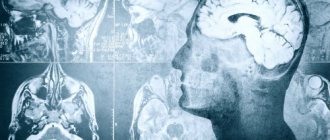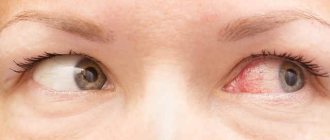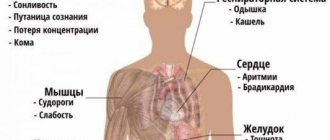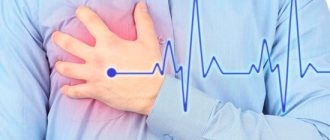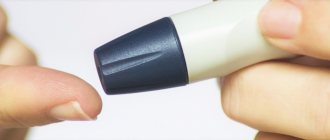Endocrinologist
Fedorov
Elena Anatolyevna
10 years of experience
Endocrinologist
Make an appointment
People diagnosed with diabetes should be aware of hypoglycemic syndrome. This is a condition that occurs when blood sugar levels drop to critically low levels. Hypoglycemia and manifestations of symptoms are variable. The phenomenon can be dangerous to health and life. A drop in sugar (glucose) levels occurs when you skip a meal or after intense physical activity. The deterioration in health occurs suddenly. It is necessary to carefully monitor your condition and know measures to prevent an attack.
All the necessary information about the disease
A person’s condition directly depends on the level of glucose in the blood. If the values drop to 1.9-2.2 mmol/l in women and to 2.5-2.8 mmol/l in men, a hypoglycemic state occurs. In people with diabetes, such jumps in indicators are not uncommon. This poses a particular danger to the brain. He is the most sensitive in this aspect. Glucose levels are regulated in the body by a number of metabolic processes. In a healthy person, hypoglycemia does not occur because the liver contains a sufficient amount of glycogen.
Treatment of hypoglycemia
Conservative therapy
To treat mild hypoglycemia, it is enough to take easily digestible carbohydrates - fruit juice, sweet tea, a few pieces of refined sugar. In case of moderate and severe severity, the patient must be hospitalized in the endocrinology department, and in case of depressed consciousness and coma - in the intensive care unit, where the following is carried out:
- Relieving hypoglycemia
. A glucose solution is administered intravenously; if the patient does not regain consciousness, drip administration continues. Intramuscular administration of glucagon is also effective (except for hypoglycemia caused by alcohol and sulfonylurea derivatives). Ascorbic acid is used to improve glucose utilization by neurons. To prevent cerebral edema in severe patients, magnesium sulfate, dexamethasone, and diuretics (mannitol or furosemide) are used. - Treatment of the underlying disease
. If the cause of hypoglycemia is a deficiency of contrainsular hormones, hormone replacement therapy (hydrocortisone, fludrocortisone, L-thyroxine) is performed. For autoimmune insulin syndrome, glucocorticosteroids, immunosuppressants, and plasmapheresis sessions are used. For the treatment of malignant insulinomas, if there are contraindications to surgery, the drug streptozocin is prescribed, which causes the death of beta cells of the pancreas. To improve the motor-evacuation function of the stomach in diabetes, prokinetics (itopride) are used.
Surgery
The most effective treatment for insulin and nesidioblastosis is surgery. In 90% of cases, the operation achieves a complete cure for the disease. The method of choice is tumor enucleation. Sometimes resection of the head, body or tail of the pancreas is performed. As a preoperative preparation, a powerful inhibitor of insulin secretion, diazoxide, is prescribed. Hyperglycemia is possible for 72 hours after surgery. To prevent it, short-acting insulin is administered. After removal of extrapancreatic tumors, glycemic levels return to normal very quickly.
How do symptoms manifest themselves?
Hypoglycemia symptoms begin to appear due to increased activity of the autonomic nervous system. And first of all, a person notices sweating. Further in different combinations there may be:
- nausea and vomiting;
- feeling of hunger;
- headache and weakness;
- drowsiness;
- frequent urination;
- blurred vision;
- lack of coordination;
- fear, panic, hand tremors;
- pallor of the skin.
Are you experiencing symptoms of hypoglycemia?
Only a doctor can accurately diagnose the disease. Don't delay your consultation - call
Clinical signs of low glucose levels
A drop in blood sugar, regardless of the cause, has symptoms:
- decreased intellectual abilities;
- disorientation, absent-mindedness;
- euphoria;
- drowsiness;
- lethargy;
- fog, spots before the eyes;
- a sharp, uncontrollable feeling of hunger.
When examining the patient, sweating, a jump in blood pressure, tachycardia, and pale skin are detected. If a hypoglycemic coma occurs, breathing, consciousness, and heart rhythm are impaired.
Reasons for the development of hypoglycemic syndrome
For the disease hypoglycemia, the causes lie in skipping meals (with an interval of more than 6 hours). The following items can also cause deterioration in health:
- insufficient amount of carbohydrates in the diet;
- excessive physical activity and stress;
- administration of an increased dose of insulin;
- use of certain types of medications;
- severe emotional stress;
- dehydration of the body.
Recommendations for the prevention of hypoglycemia
People with diabetes should be responsible about their diet and insulin administration: do not skip meals, calculate the dose of insulin, measure glucose with a glucometer before and after meals.
It is recommended to always have lollipops, pieces of refined sugar or glucose tablets with you to eliminate the first manifestations of hypoglycemia.
If episodes of hypoglycemia not related to diabetes occur frequently, you should consult an endocrinologist or physician.
What are the varieties?
It is worth noting that hypoglycemia itself is not a disease in the classical sense. This is a condition that occurs due to certain factors and accompanies different types of diseases. Most often we are talking about diabetes mellitus. In medical practice, there are several stages of this condition:
- easy (a person can help himself independently);
- medium (requires help from other people);
- severe (the most severe stage, when a person falls into a hypoglycemic coma).
Possible complications
Signs of hypoglycemia should not be ignored. The deterioration of the condition develops quickly. The worst complication is coma, when a person does not receive timely help and the blood sugar level drops below minimum values. Among the complications, it is necessary to highlight the negative impact on small peripheral vessels that are subject to destruction. The legs and eyes are at risk. The legs and eyes are the first to be affected. Over time, blindness and angiopathy (pathology of the retinal vessels of the eye) may develop. If the sugar level drops below 2 mmol/l, the brain is at risk.
Pathogenesis
Glucose is the main energy substrate for the central nervous system. Therefore, the central nervous system is very sensitive to hypoglycemia. First, as a compensatory reaction, counter-insular hormones are released into the blood, including catecholamines (adrenaline, norepinephrine), which cause vegetative symptoms. If glucose continues to be low, neuroglycopenia occurs.
Brain cells (mainly the cerebral cortex, diencephalic structures) begin to experience energy starvation, all metabolic processes, redox reactions, etc. are inhibited in them. Persistent hypoglycemia affects the medulla oblongata and the upper parts of the spinal cord, which leads to suppression of reflexes, convulsive readiness of the brain, impaired consciousness, and coma. Pathomorphological changes include edema, necrosis of certain areas of the brain.
Information about diagnosis and treatment
It is quite simple to notice and determine a change in condition, which is due to characteristic symptoms. For this reason, diagnosis of hypoglycemia is based primarily on an initial analysis of the patient’s condition. After the examination, a number of tests and studies are prescribed to clarify the etiology and diagnosis:
- blood and urine tests;
- study of blood glucose concentration;
- biochemical blood test with determination of albumin and protein;
- urine glucose test;
- insulin level studies;
- assessment of the function of the thyroid gland, pituitary gland and pituitary-adrenal system;
- Ultrasound of the abdominal organs.
Hypoglycemia is a condition characterized by a decrease in glucose (sugar) levels in the blood.
Glucose is a carbohydrate that is the main source of energy in the human body. For normal functioning it is necessary to maintain a certain level of sugar in the blood. This is achieved through several mechanisms.
The flow of glucose from the blood into cells for further inclusion in biochemical processes is carried out thanks to the pancreatic hormone insulin. It reduces the concentration of sugar in the blood. With its deficiency, diabetes mellitus develops, which is characterized by elevated blood glucose levels and metabolic disorders.
Part of the glucose ingested from food is stored in the liver in the form of glycogen. When blood sugar levels drop, glycogen is broken down to release glucose (glycogenolysis). The liver also synthesizes glucose from other metabolic products - gluconeogenesis. When the amount of glucose in the blood decreases due to glycogenolysis and gluconeogenesis, the concentration of sugar in the blood increases.
The causes of hypoglycemia are varied: insulin overdose in patients with diabetes, diseases of the liver, kidneys, heart, development of insulin-producing tumors, alcohol intoxication, etc.
The brain is most sensitive to a decrease in the amount of glucose in the blood. For this reason, with hypoglycemia, disorders of the nervous system come to the fore.
Treatment of hypoglycemia is to increase blood glucose levels. In mild forms of the disease, this is achieved through oral consumption of carbohydrates (for example, candy, sweet juice). In more severe cases, intravenous administration of glucose solution is necessary.
An important point in treatment is the elimination of the causes that caused hypoglycemia (for example, removal of an insulin-producing tumor).
Synonyms Russian
Low blood sugar.
English synonyms
Hypoglycemia, low blood sugar.
Symptoms
Hypoglycemia may have the following symptoms:
- hunger;
- sweating;
- anxiety;
- nausea;
- heartbeat;
- trembling in the limbs;
- paresthesia - numbness, tingling, crawling;
- headache;
- fatigue, weakness;
- drowsiness, decreased ability to concentrate;
- visual disturbances (eg, double vision);
- disturbance of consciousness up to coma;
- convulsions (in rare cases).
General information about the disease
Hypoglycemia is a condition characterized by low blood sugar levels.
Glucose is the main source of energy in the human body. It comes with food as a part of simple and complex carbohydrates and, being absorbed in the gastrointestinal tract, is transported into the blood. The pancreatic hormone insulin promotes the penetration of glucose into cells, where it is included in energy processes. In this way, insulin lowers blood sugar levels.
Some glucose is stored in the liver in the form of glycogen. When sugar levels drop, the concentration of glucose in the blood may increase due to the breakdown of glycogen. The body is also capable of synthesizing glucose from a number of other metabolic products - this process is called gluconeogenesis. These mechanisms are aimed at maintaining sugar levels within certain limits, which provides optimal conditions for the normal functioning of the body.
With hypoglycemia, neurological disorders appear first, this is explained by the high energy needs of nerve cells. Reactions from the autonomic nervous system develop, such as sweating, rapid heartbeat, hunger, anxiety, etc.
Lack of energy impairs the functioning of the brain. This causes fatigue, headache, drowsiness, and inattention. Severe forms of hypoglycemia are characterized by depression of consciousness up to coma with possible death in the absence of medical attention.
The causes of hypoglycemia are varied. Some of them are listed below.
- Diabetes. Patients with diabetes have elevated blood glucose levels, which causes various metabolic disorders. In this case, severe complications develop from the cardiovascular, nervous system, kidneys and other internal organs. The main treatment for insulin-dependent diabetes mellitus is insulin injection. An injection that exceeds the required amount may cause hypoglycemia. In addition, hypoglycemia can occur if a person performs intense physical activity after administering insulin and eating. When muscles work, a large amount of energy is expended, the main source of which is glucose. This factor, combined with the administered dose of insulin, can cause manifestations of hypoglycemia.
- In people who do not have diabetes mellitus Use of certain medications (for example, quinine, used to treat malaria). This applies to a greater extent to people suffering from kidney and liver diseases, which is explained by the slower elimination of the drug from their body.
- Alcohol abuse. Drinking large doses of alcohol without eating disrupts the formation of glucose from other metabolic products (gluconeogenesis). Hypoglycemia in such patients often develops after depletion of glycogen reserves in the liver, the breakdown of which could increase blood glucose.
- Severe diseases of internal organs. In severe pathologies of the liver, kidneys, and heart failure, processes may develop due to dysfunction of the affected organs. The consequence of this is hypoglycemia.
- Reactive hypoglycemia is a decrease in blood sugar levels after a certain period of time after eating food. Characteristic of patients who have undergone surgical interventions on the stomach and upper parts of the small intestine, after which food may not be retained in the stomach, as is normal. It quickly enters the intestines, where glucose is absorbed, which causes a sharp increase in blood sugar levels and excessive release of insulin, followed by the development of hypoglycemia.
- Insulin-producing tumors of the pancreas.
Who is at risk?
- Suffering from diabetes.
- Alcohol abusers.
- Taking certain medications (for example, quinine to treat malaria).
- Those who have undergone surgery on the stomach and upper small intestine.
- Having some endocrine disorders (for example, adrenal hypofunction).
- Suffering from severe liver and kidney diseases.
Diagnostics
Diagnosis of hypoglycemia consists of identifying characteristic symptoms associated with low blood sugar levels. To identify the causes of hypoglycemia, a number of laboratory tests and special studies are required.
Laboratory research
- Plasma glucose. When its level is below the threshold value of 2.2 mmol/l.
- Insulin. This is a pancreatic hormone that transfers glucose from the blood into cells, where it enters into biochemical processes. It lowers blood sugar levels. Hypoglycemia may be caused by elevated insulin levels in the presence of an insulin-producing tumor.
- Oral glucose tolerance test. The patient is given a glucose solution to drink, after which the glucose and insulin levels are recorded at certain intervals. For example, patients who have had part of their stomach removed may experience reactive hypoglycemia. This means that after taking glucose, the blood sugar level rises rapidly, resulting in increased insulin secretion with the subsequent development of hypoglycemia.
- Determination of glucose levels during a fasting test. The fasting test can last up to 72 hours.
- Proinsulin is a protein that is a precursor to insulin. It is synthesized by islet beta cells of the pancreas. With insulinomas (tumors that produce insulin), its level in the blood increases, which leads to hypoglycemia.
- C-peptide in serum is one of the components of pancreatic secretion, which is necessary for the synthesis of insulin. In insulin-producing tumors, its level in the blood serum is increased.
Given the variety of pathological conditions that can cause hypoglycemia, a number of other laboratory tests (for example, assessment of liver function, kidney function, determination of adrenal hormone levels) may be required to identify its causes.
Other studies
- Magnetic resonance imaging (MRI). The principle of the method is based on the action of a strong magnetic field on human tissue. The received information is subjected to computer processing, and as a result, highly accurate layer-by-layer images of the internal structures of the body are formed. In case of hypoglycemia, the method can be used to identify insulin-producing tumors.
Treatment
Emergency treatment for hypoglycemia is to normalize blood sugar levels. For mild forms, quickly digestible carbohydrates (sweet juice, candy) are used. In more severe cases, glucose solution is administered intravenously.
It is very important to identify the causes of hypoglycemia and treat diseases that lead to low blood sugar levels (for example, removing insulin-producing tumors).
Prevention
Prevention of hypoglycemia in patients with diabetes consists of strict adherence to the insulin therapy regimen and diet developed by the attending physician.
For patients who do not have diabetes, the main preventative measure is to identify and eliminate the causes of hypoglycemia. As a temporary measure, eating small portions at short intervals can be used.
Recommended tests
- Plasma glucose
- Insulin
- Oral glucose tolerance test
- Proinsulin
- Serum C-peptide
Literature
- Dan L. Longo, Dennis L. Kasper, J. Larry Jameson, Anthony S. Fauci, Harrison's principles of internal medicine (18th ed.). New York: McGraw-Hill Medical Publishing Division, 2011. Chapter 345.Hypoglycemia.
Self-monitoring of general condition
Hypoglycemia is a condition that can be self-controlled when it is mild. Thus, people with type 1 diabetes monitor their blood sugar levels without the help of doctors and make the necessary adjustments. The diet for hypoglycemia consists of consuming foods with a low hypoglycemic index. It is recommended to avoid those foods that can cause a sharp jump in blood glucose levels. This list includes candies, cookies, cakes and other sweets with fast carbohydrates. They can be used in small quantities if the condition worsens.
First aid for hypoglycemic coma
If a person exhibits signs of mild hypoglycemia (without impairment of consciousness, convulsions or hallucinations), it is enough to compensate for the glucose deficiency with simple carbohydrates:
- lollipop;
- a tablespoon of honey or sugar;
- tea with sugar or sweet juice;
- a piece of milk chocolate;
- glucose tablets (diabetics with a tendency to hypoglycemia usually carry them with them).
We give the victim something from the offer and wait. If there is no improvement after 15-20 minutes, call an ambulance.
If the person is already unconscious and it is not possible to give him something sweet to eat or drink, call an ambulance.

